How To Build A Rock Garden Wall That Actually Last
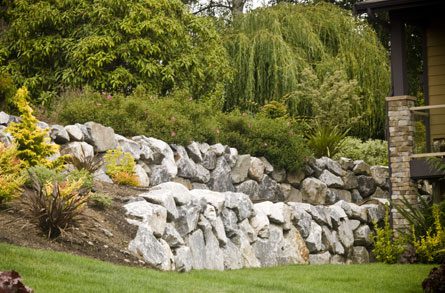
Rock Garden Wall A rock garden wall or retaining wall is a type of wall that you can build in your garden without the use of mortar or the need for concrete footing. This type of wall can be built using a variety of rock types but there is a method to follow if you’re wondering how to build a rock garden wall. To help you build your retaining wall, the rockery experts here at New Life Rockeries have written down the following step-by-step process for how to build a retaining wall of your own. One thing to note before beginning is considering the size and purpose of your retaining rock wall. If it needs to be four or more feet in height, and if the thing it is retaining is particularly important or expensive, then you should consider building a properly engineered wall instead. If your wall is around three feet high and is retaining a layer of lawn or a flower bed, then you can certainly tackle this yourself using this process. How To Build a Retaining Wall: Materials and Preparation Two of the most popular stone types for this kind of wall are fieldstones and flagstones (made from limestone). Both are of an ideal size, shape, and weight for a retaining wall, and are manageable enough for any homeowner to use as building materials. The main tools you will need are a shovel, hammer and chisel, and a spirit level. Make sure to wear thick, sturdy gloves when handling your rocks. Sturdy shoes are also essential. Related Article: https://newliferockeries.com/purpose-of-retaining-wall/ Before you begin stacking your wall, sort your stones first. This saves time and makes the process simpler. Your wall will begin and end with the flattest stones you have, so sort those into their own pile first. If your wall has corners, sort the roundest stones into a pile which will be used to form the corner of the wall. How To Build a Rock Garden Wall Now that your stones are sorted, it’s time to follow this step-by-step process on how to build a small retaining wall: Select the location of your wall and dig a trench approximately twelve inches deep. The trench should be wide enough to fit your flattest stones. These flat stones will be the retaining wall’s first layer (also known as a course). Lay the flat stones in the trench, keeping them close together. Check them with the spirit level as you go to ensure they are consistently level across the trench. Your goal is to build a solid first course of flat stone as a foundation for the rest of your wall. From here, keep enough flat stones leftover for the top course and use the other, less flat, stones to build the middle layers of your wall. This method of placing the flattest stones at the bottom and top is key when considering how to build a rock garden wall. As you continue to steadily build your wall’s layers, make sure to fill in any gaps with smaller rocks and pebbles, and avoid using anything like soil or mud. Your retaining wall should be made entirely of stone. Remember to complete one layer before moving on to the next. It is essential that the wall remains constantly level, so keep checking and measuring the level of each layer as you go. Also make sure that you are selecting stones which slot together well, ensuring the smallest number of gaps possible. To complete your wall, make the top layer out of your remaining flattest and smoothest stones. This will ensure the strongest and most aesthetic finish. Get Expert Help for Your Rock Garden Wall If you are wondering how to build a retaining wall on a slope or need help with other technical questions, please contact the rock wall experts at New Life Rockeries. Our retaining wall contractors have been building walls since 1975 and can answer your questions or provide you with a construction estimate for your own rock garden wall.
Landscaping Rock Walls
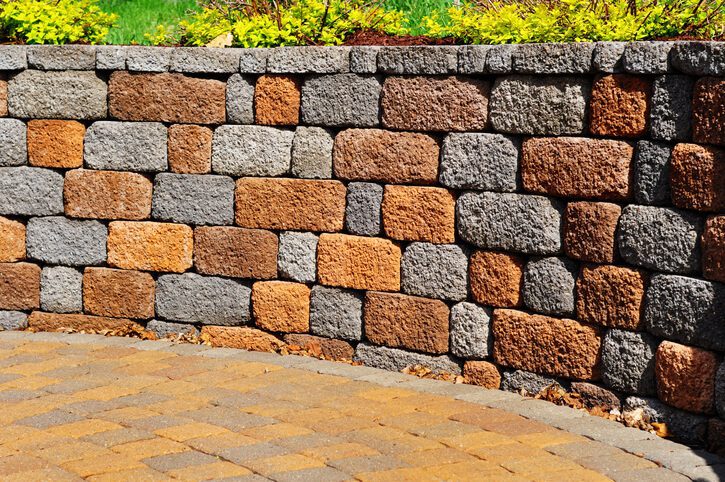
Ideas For Landscaping Rock Walls Whether you’re looking at rock wall landscaping or boulder walls landscaping, this is a technique that can be traced back centuries. Take a trip through the English Cotswolds and you’ll find beautiful rock walls that have stood since the middle ages. This technique made its way to New England from old England and is now a popular, aesthetic style across the United States. Landscaping rock walls offer some fantastic benefits, both practical and aesthetic, and time has proven them to be a unique but efficient choice for homeowners looking to build with retaining wall contractors. The two main options for building landscaping rock walls are to build with rocks or boulders. This choice can be made based on aesthetic tastes or on what you have available in terms of resources and space. Here’s everything you need to know about landscaping rock walls. Rock Wall Landscaping Also known as stone wall landscaping, this approach to building a retaining wall involves using a large selection of smaller stones and rocks to form a wall, the height and width of which is mostly up to you, though, if you are going with the traditional mortarless method, the wall should be no taller than three feet. How a Rock Wall Can Help The main purpose of landscaping rock walls is to separate different levels of land, ensuring that all of the space in your yard is being fully utilized while also looking pleasing to the eye. What makes rock retaining wall landscaping unique is the fact that it requires no mortar or even a concrete footing. Everything is free-standing. Related Article: https://newliferockeries.com/types-of-landscaping-stone/ For a landscaping rock wall to work, you do need to consider your materials as well as your location. The wall also requires a trench which measures twelve inches deep and has a width which is half the height of the wall itself. Boulder Walls Landscaping This is the second approach to creating your own retaining wall. As the name suggests, boulder wall landscaping involves using much larger boulders to create your wall, rather than a larger number of smaller rocks and stones. While this method can be more expensive, due to the equipment required to move and properly install the boulders, it does have some of its own unique benefits. How a Boulder Wall Helps Your Landscape The largest benefit of building a boulder wall is the natural drainage it offers. Because of the gaps between boulders, excess water runoff is easily drained away. This comes in particularly useful for homeowners looking to build a large garden on the layer above the boulder wall. Tips for Landscaping Rock Walls If you are considering rock wall landscaping, here are a few tips that are worth keeping in mind before you get started: Think about the type of stone or boulder you want to use. There are a number of options so do your research or consult an expert before you commit. Consider your location carefully. This will determine how the wall looks, how it is used, as well as how tall and wide it will end up being. When assembling your stone wall, remember to keep your flattest stones for the initial bottom later and the final top layer of your wall. Before you do anything, check with your local building authority for any codes or regulations. Permits may be required and inspections may need to be carried out. Professional Rock Wall Landscaping Near You Are you looking for an expert opinion on which kind of rock wall you should install on your property? Here at New Life Rockeries, our team of professional landscaping contractor have been building rock walls since 1975. Contact us today to get your questions answered and to request an estimate for your own rock or boulder wall.
Guide On How To Lay Landscape Rock
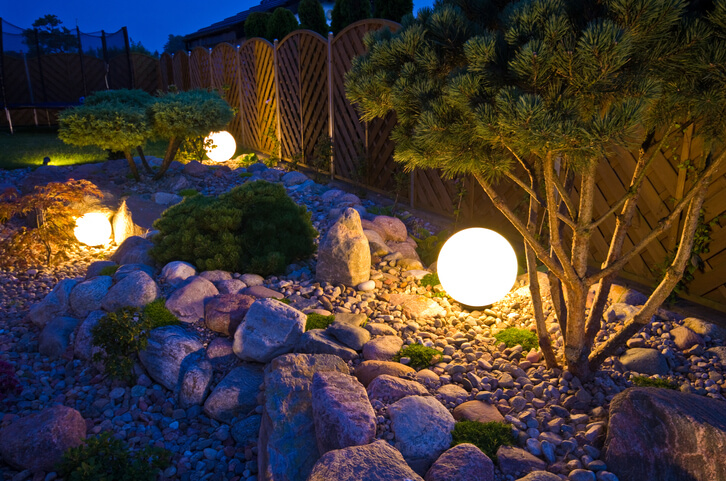
A Guide To Properly Laying Landscaping Rocks Landscaping rocks make an excellent addition to any outdoor space. Whether you’re using rock landscaping as a decorative or practical feature, this article will help you understand how to lay the rock in order to create the best decorative rockery. How To Lay Landscape Rock Here’s your detailed guide for how to prepare for and lay landscape rock. If you have any rockery questions or would like to schedule our team of landscape contractor professionals to come and lay your landscape rock, give us a call. No matter how big or small your landscaping project, our team of rockery experts would be happy to help you. 1. Choose Your Rock The first step in creating any decorative stone feature is to select your rock. You may look up different designs online or visit a local rock quarry for inspiration. Selecting your decorative stone will determine how your landscape turns out, so don’t feel shy about taking your time during this step. 2. Choose a Design Before you begin laying the rock, you will first need to choose a design that resonates with you and your goal landscape. Are you hoping to install a decorative stone pathway or a rock garden? Or is the landscape rock purely for the purpose of diminishing weed growth? Deciding on your preferred landscape design will ensure that you or the landscaping contractor you hire are able to lay and recreate the rock landscape you want. 3. Prepare the Area Once you’ve chosen your rock landscape design, it’s time to prep the site. Weed the area where you intend to lay the rock landscape, level it, and remove loose stones or other debris before starting on your project. A clean slate is best when it comes to laying landscape rock and decorative stone. 4. Lay Decorative Stone Now that you have your decorative stone picked out, your design chosen, and the area cleared, it’s time to set to work laying the landscape rocks. If you are following a specific guide to achieving your landscape design, pay close attention and follow each step carefully. Once the landscape rocks have been laid, sit back and enjoy your finished work of art! Related Article: Rock Wall Landscaping Services Contact a Landscape Rockery Service Today Don’t have the time to lay your rock landscape yourself? No worries! Give New Life Rockeries a call today to schedule our crew to come lay your rock landscape for you. Whether you need help selecting a rock landscape design, choosing decorative stones from a quarry, or laying the landscape rock, we have you covered. Our team of landscape professionals would be happy to help you lay a decorative stone path or create a stunning rockery. To learn more about our custom rockery services or to get a quote for your project, contact New Life Rockeries today.
How To Build A Rock Wall

A Guide To Building A Great Looking Rock Wall Looking to add a new outdoor addition to your landscape? Rock retaining walls are an excellent way to add beauty and creativity to your outdoor space while also increasing your landscape’s practicality. Here’s a step by step guide for how to build a rock wall at your home. How To Build a Rock Retaining Wall: Step by Step DIYing a rock retaining wall can be a fun project for homeowners. Here’s your intensive guide for how to build a rock wall, if you have any questions, give New Life Rockeries a call to speak with retaining wall contractors. 1. Choose Your Rock or Stone Choosing the right stone for your stone retaining wall is the first step to building an excellent outdoor addition. Find a local rock quarry and select a stone type that you think would work well in your outdoor space. You want to choose a type of rock that will stack well and is medium to large-sized. 2. Outline Your Spot The next step in how to build a rock retaining wall is to outline the excavation site. Use wooden or metal stakes to outline the spot where you’d like to build your retaining wall and run a string between two of the stakes to act as your guide and level. 3. Begin Building Your Rock Retaining Wall The first step to the actual building process is to dig a small trench up to 12-inches deep. You do this in order to create a level wall and a sturdy base. Lay the gravel foundation before beginning with your first layer of rock. Once you’ve laid the foundation of your rock retaining wall, make sure that you check that the first layer is level. 4. Build Your Rock Wall Higher Congratulations! The foundation of your rock retaining wall completed, work on building your wall higher. Stagger each layer that you add and check after each one to make sure that the wall is still level. 5. Complete Your Rock Retaining Wall Completing your rock retaining wall will be done with capstones which can be secured in place with a strong glue. And voila! Your rock retaining wall is finished! Related Article: Retaining Walls that Stand Their Ground Contact a Retaining Wall Installation Service If you have any questions about how to build a rock retaining wall or would like to hire a professional landscaping contractor to build one for you, contact New Life Rockeries today. Here at New Life Rockeries, we’ve been serving homeowners in and around Seattle for the past 30 years. We are passionate about landscape improvement and artisan outdoor work. We want to be the ones to bring new life and vibrance to your landscape through our work. Our team of landscape experts and retaining wall designers have experience working with a wide range of landscapes and outdoor spaces. To get started improving your landscape, contact New Life Rockeries today. We’d be happy to work up a custom quote for your retaining wall project.
Rock Wall Landscaping Services
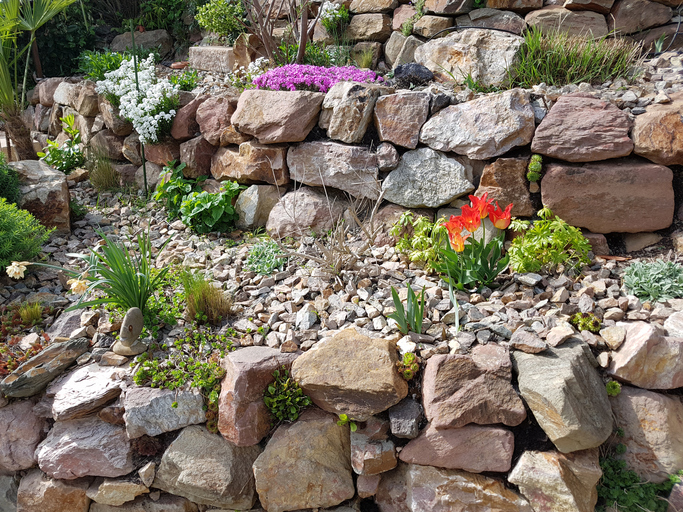
It is time to give your landscape a makeover? Having a rock wall installed is a simple, practical, and effective way to give your landscape an immediate facelift. Not only do rock walls match virtually every landscaping style, but they can also be installed in a minimal time frame and don’t break the budget. As someone considering having a rock wall installed in your landscape, give New Life Rockeries a call for tips on how to choose the best rock wall design for you. Rock Wall Landscaping Ideas Hiring a professional rockery team means that in just a day or two, you could be enjoying a beautiful rock wall in your landscape. If you are eager to get started and make the addition to your outdoor space, here are rock wall landscaping ideas to get the creativity flowing. Staggered Rock Wall Staggered rock walls add a sense of natural beauty to the landscape that they’re in. They can be made from any type of rock or stone depending on your preference. Staggered rock walls are usually installed not just for decorative purposes but also to prevent soil erosion. Rock Wall Backdrop Another landscaping idea is to have a rock wall installed to serve as a backdrop. Your rock wall could be a backdrop for a rock garden, flower bed, patio, or water feature. Rock Wall Lining a Path Another landscaping idea is to have your rock wall installed to line a pathway. This rock wall could act as a barrier to prevent pets or guests from stepping on your grass or in flower beds that line the path. How a Rock Wall Benefits Your Landscape OR Reasons to Have a Rock Wall Installed in Your Landscape Rock walls are extremely beneficial to any landscape. Here are a couple of the biggest benefits of having a rock wall installed in your landscape. A Rock Wall Can Bring Your Landscape Together A rock wall might just be the thing you need to bring your entire landscape together. Rock walls act as a binding feature in what would otherwise be a disconnected landscape. If you are struggling to bring your landscape together in a cohesive design, a rock wall is the perfect addition to get it done. Rock Walls Create a Good Backdrop As mentioned above, a rock wall can make a good backdrop for your real landscape focal point. A rock wall will make whatever landscaping there is in front of it pop, which is helpful if you are trying to create a specific focal point. Rock Walls Serve a Practical Function in Your Landscapes Rock walls are often not only there for decorative purposes, but also serve practical functions. A rock wall might be installed to stop the erosion of soil from ruining your landscape or to aid with drainage issues. A landscape piece that improves practicality and boosts outdoor aesthetics is a good addition to any outdoor space. Contact a Rockery Landscape Service Today If you want a custom rock wall designed for your landscape, give New Life Rockeries a call. We’ve been in the business of rock wall design and installation for more than 35 years and we want to help you perfect your landscaping with a landscape contractor. To get a custom quote for your rock wall installation, contact us today!
Types of Landscaping Stone To Use for Your Seattle Home
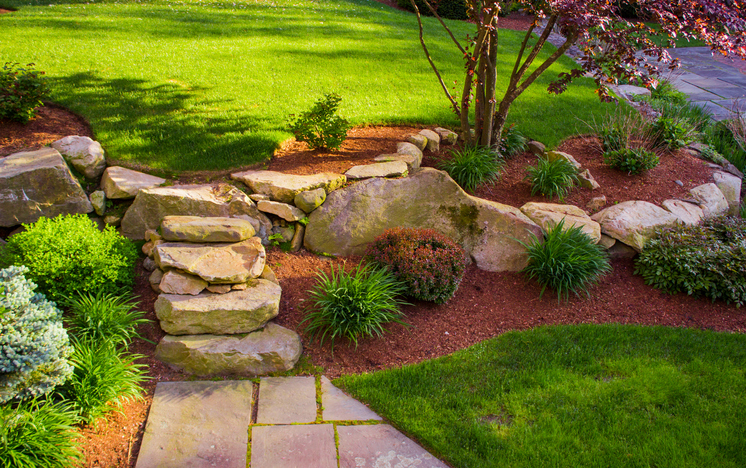
Wondering what types of landscaping stones are available for you to use in your Seattle home’s landscape? You’ve come to the right place. For over 35 years, the rockery experts here at New Life Rockeries have been laying landscaping stone around Seattle. Here’s a list of the different types of stone for landscaping that we recommend. Different Types of Stone Used For Landscaping Here are seven of the most popular types of stone used in Seattle landscaping. If you have additional questions about any of the types of stone mentioned, give New Life Rockeries a call. New Life Rockeries is a Seattle landscaping contractor team that is ready to help you update your landscape. Pea Gravel This is made up of small pebbles of varying sizes and colors. It is one of the most common types of stone used in Seattle landscape designs and can be used in a wide variety of different landscape styles. Pea gravel can be used as a filler, in garden beds, or in patio designs. Crushed Granite This is one of the most common types of stone used in Seattle landscapes. It’s versatile, natural in appearance, and is most often used for walkways or driveways. In color, it’s often a light gray or slightly pinkish. River Rock River rock can come in large or small sizes and are generally smooth in texture and found in a range of colors. This stone is popular in Seattle landscapes that are looking for a muted, natural, or beachy vibe. River rock is used in rockeries, rock gardens, and pathways. Lava Rock This is an excellent type of stone that can be used in many different kinds of Seattle landscapes. Lava rock is usually coal-black or red in color and has a rough, porous exterior. It is a decorative material and can be used in rock gardens or pathways. Slate Chips Slate chips give Seattle landscapes an industrial, minimal look. Slate comes in various shades of gray and coal and can be an excellent choice for homeowners who enjoy contrasting outdoor elements. Meramec A medium-sized stone, Meramec comes in varying shades of bronze, tan, and caramel and is a wonderful choice for landscapes that need texture. Meramec is a popular type of stone used in Seattle landscapes due to its irregularity in size and more natural appearance. Sandstone Sandstone offers Seattle homeowners a lot of variety. This type of landscaping stone comes in varying sizes, colors, and shapes. Due to being a softer stone type, sandstone may even be cut to desired shapes and sizes. Sandstone does well in many different kinds of landscapes but is especially appealing in urban and city landscapes. Contact a Seattle Landscaping Service Today Ready to make the upgrade towards a new and improved landscape? Give New Life Rockeries a call today. Our team of landscape professionals would be happy to help you install a rockery or rock garden at your Seattle home. Contact us today to schedule a date for us to get started perfecting your landscape.
Things To Know About The Alpine Rockery
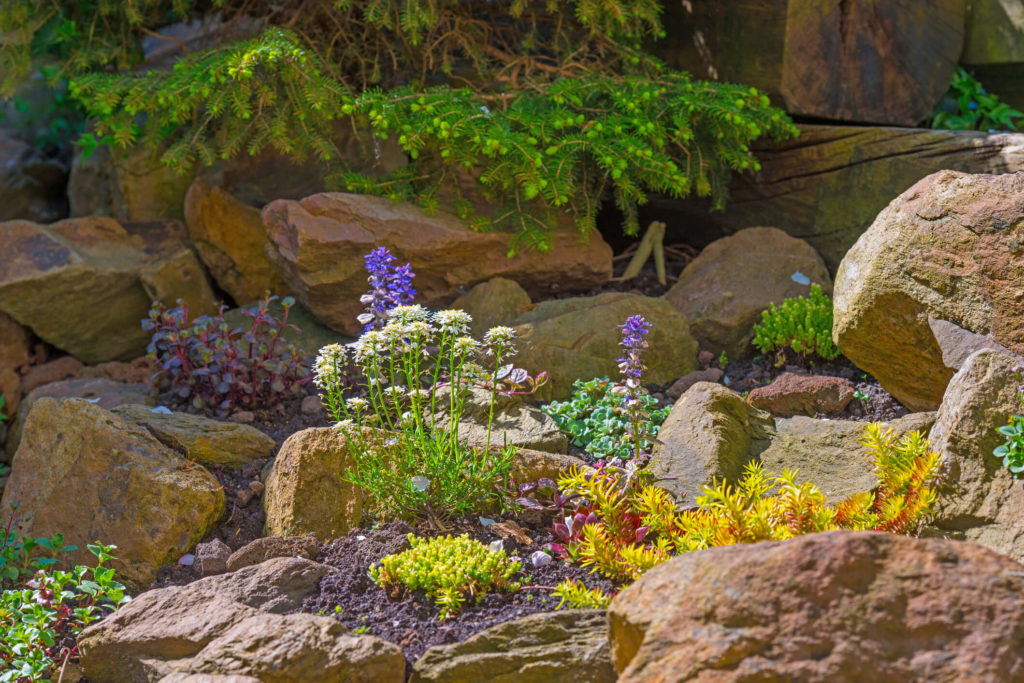
Alpine rockeries are an excellent landscaping solution for homeowners who want a low maintenance outdoor space. They are compact, aesthetically pleasing, and generally require very little upkeep. What is an Alpine Rockery? An alpine rockery is a landscape design that mixes rock gardens with alpine plants to form a low maintenance landscape. Alpine rockeries are the perfect solution for small outdoor spaces or homeowners who don’t have a lot of time for landscape maintenance. Alpine gardens are perfect for city residences as they don’t require excessive space or attention and still look wonderful. What are alpine plants? You might be wondering. Alpine plants are those that were originally mountainous but have since been planted in all different types of landscapes. In general, alpine plants are evergreen, and so keep your alpine rockery bright all year round. Some popular alpine plants include: Sempervivum Sedum Lady Fern Kinnikinnick Deer fern And more! Alpine plants are the perfect way to deck out a rockery and are very versatile. Alpines come in all shapes, sizes, and colors and make the perfect addition to any rockery or garden. Another bonus to having an alpine rockery added to your landscape is that no matter what time of year it is, you will be able to find a store carrying alpines. Benefits of Having an Alpine Garden Installed Here are some of the best benefits of alpine rockeries in your landscape. Low maintenance: alpine rockeries require minimal watering and occasional weeding to make your outdoor space look trendy and fresh. Affordable: alpine plants are easy and affordable to come by. If you have a small garden, such projects are usually quick and low cost. Gorgeous in any landscape: whether you have a city residence or a suburb home, alpine rockeries make a fantastic addition to any landscape. You will never regret the simplicity, beauty, and earthy tones that an alpine garden can immediately accomplish in your landscape. Tips for Making an Alpine Rockery Here are several tips for how to make alpine rockeries. Choose a sunny spot: as mentioned, alpine plants are used to growing on sunny mountainsides. Alpine gardens don’t do as well in the shade, so it’s essential to choose a spot in your yard with direct sunlight. Check the drainage: alpines are naturally drought-resistant plants and do well in dryer climates. Check and make sure that the area where you are planting your alpine garden has good drainage and doesn’t flood during rainy seasons. Hire a professional landscaping service to design your alpine rockery: and this last tip brings us to: Contact an Alpine Rockery Installation Service At New Life Rockeries, we have more than three decades of experience helping homeowners design the perfect landscape. We are proud to offer quality landscaping, alpine rockery installation, and outdoor design services. If you have questions about having an alpine garden installed or want to get a quote from our team, give us a call today. Our team of landscape contractor professionals would be happy to help you design and install your alpine rockery dream. Contact us today to get your custom alpine rockery quote.
Summer Landscaping Tips To Make Sure Your Lawn Is Well Maintained
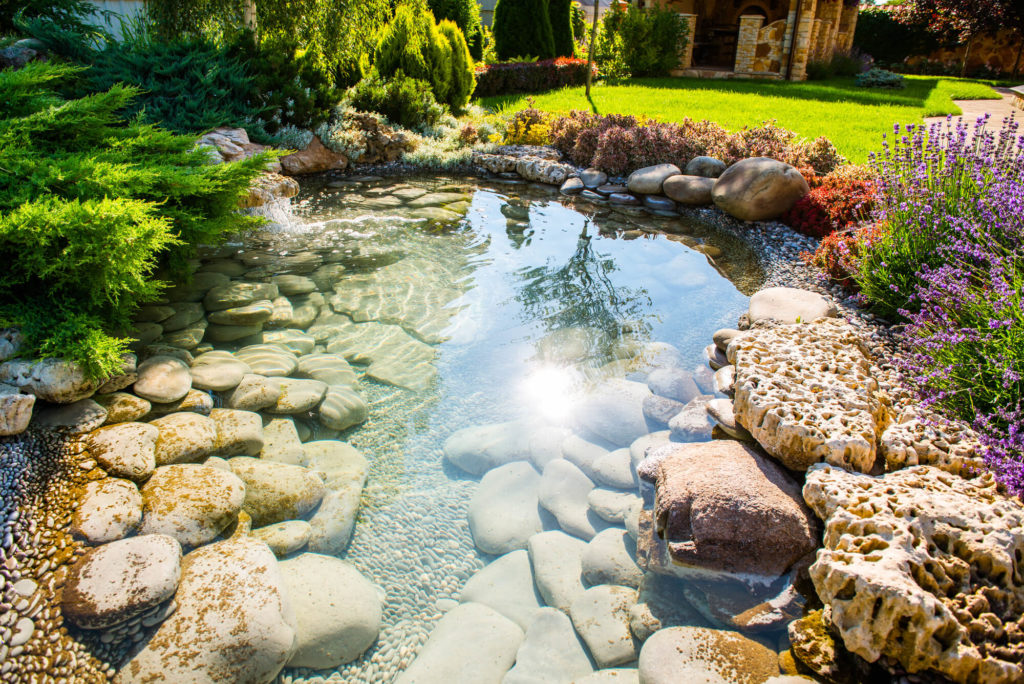
Summer is the best time of year in the Pacific Northwest. For many homeowners, this means family get-togethers, backyard barbecues, and naps in comfy patio chairs. If you’re planning on hosting a lot this summer and want to make sure that your summer landscaping is on point, here are several summer landscaping tips and ideas so that you can have fun at gatherings and impress your guests with your outdoor space. Don’t Assume Your Grass is Getting Enough Water All too often, Washington homeowners make the mistake of thinking that because the climate is mild and rain is frequent that their lawn is getting enough water. This is not always the case though, and losing track of what the weather has been up to can result in your lawn becoming brown and dry. Replacing a dead lawn is a lot more work and far more expensive than taking a bit of time to water it when needed, so make sure to put lawn watering on your schedule. Pro landscaping tip: make sure that you don’t water your lawn during the hot time of day, but instead water in the morning or evening before the sun is at full strength. This minimizes evaporation and gives your grass time to absorb the water before the sun dries it all up. Mow Your Lawn Correctly There are several tips you need to follow when moving your lawn during summer months. Make sure that your mower has sharp blades and is well maintained. An ill-maintained or dull lawnmower can do a lot of damage to your lawn. Take care to cut your lawn to the correct height. Most landscaping services recommend around two and a half to three-inch lawns during the summer months. Don’t cut your lawn too short. Cutting your lawn too short puts it at risk of weed infestation and browning from drought. Pro landscaping tip: try to mow your lawn in the morning before the sun has come up as this is the healthiest for your lawn and will yield the best results. Keep the Pests Away You can’t enjoy an evening outdoors when there are bugs and pests in abundance. Thankfully, there are certain hacks you can use to make your lawn and landscape less friendly to insects. Certain plants such as lavender, rosemary, fennel, and marigolds can help repel mosquitoes. Another tactic is to dot your landscape with tiki torches to keep mosquitoes at bay. Contact a Summer Landscaping Service Near You If you need help preparing your landscape for this summer, give New Life Rockeries a call today. We have a team of summer landscaping contractor professionals who are ready to help you with sod installation, pathways, retaining walls, excavating, waterfalls, and more. We’ve been serving homeowners in the Pacific Northwest for over 35 years. We have the expertise and equipment to help you in getting your summer landscaping contractors all decked out and ready for this year’s gatherings. If you’re ready to unlock your landscape’s potential, contact New Life Rockeries for your summer landscaping quote today.
The Purpose of A Retaining Wall: Pros and Cons
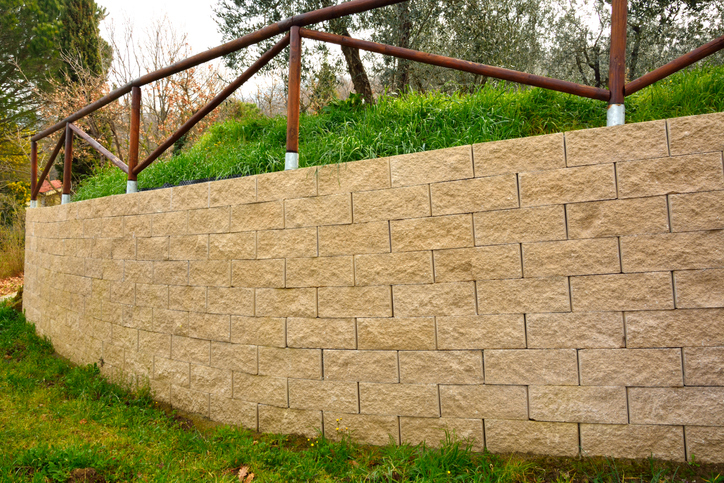
As a homeowner, one of the landscape topics that you hear discussed often is the question of retaining walls. Are they important? Should you have one installed? Understanding the purpose of a retaining wall and whether or not one would be beneficial to your home and landscape is more nuanced than it may at first appear. This article will help you understand the purpose of retaining walls, possible pros and cons to having one, and whether or not you should have a retaining wall installed at your home. What’s the Purpose of a Retaining Wall Retaining walls serve several purposes. Using it as a barrier can prevent soil erosion in homeowner’s yards. It can also assist with drainage issues in a landscape. Retaining walls might also be installed just for the purpose of being aesthetically pleasing in a landscape. Retaining Wall Pros and Cons What are the pros and cons of retaining walls? Here’s a brief overview of some of the pros and cons that homeowners might encounter after having a retaining wall installed at their residence. Retaining Wall Pros: They prevent soil from eroding and from spilling into your yard Retaining walls prevent flooding in your landscape These walls keep surrounding structures safe from elements that would damage them They are a great decorative feature in a well-landscaped yard Retaining walls reduce the amount of maintenance that many homeowners have to deal with due to erosion Retaining Wall Cons: Here are some possible retaining wall cons. Please note that these cons do not always occur, the quality of your installation directly correlates with how many issues you will encounter with your retaining wall. Ongoing maintenance and repair on your retaining wall (well-constructed walls need very little maintenance) An ineffective retaining wall (if you are having your retaining wall installed to serve a specific purpose, like drainage, then poor construction can mean that the wall fails to serve its purpose) Do You Need a Retaining Wall at Your Home Here are several questions that you should ask yourself to determine whether or not you need to have a retaining wall installed. Is dirt erosion a problem in your landscape? If there is dirt spilling over into your yard, this is an indication that you need to have a retaining wall installed to act as a barrier to the soil. Is your home downhill from a soil fault line? Even if this doesn’t currently cause you any problem, having a retaining wall there just in case of sudden erosion (which could be caused by an earthquake) will give you peace of mind. Do you have drainage problems in your landscape? Installing retaining walls will help with drainage issues. Are you looking for a low maintenance, practical, and beautiful landscape addition? Retaining walls are a simple, low maintenance way to liven up your outdoor aesthetic. Need a Quality Retaining Wall Installed at Your Home? Are you looking for a reliable Seattle retaining wall contractors installation service? If you’ve decided it’s time to have a retaining wall installed at your home, call New Life Rockeries. We have a team of landscaping professionals who prioritize quality retaining wall installation and customer satisfaction. If you have any retaining wall questions or would like to get a quote on retaining wall installation, contact New Life Rockeries today.
3 Reasons Why Retaining Wall Failures Occur
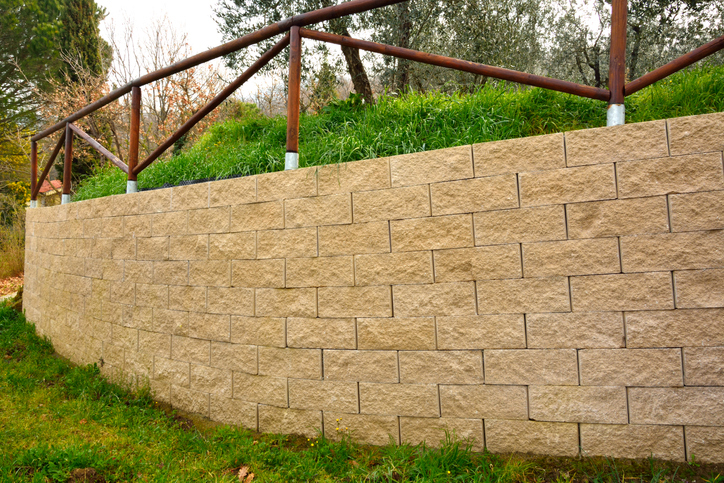
As a home or business owner, you might have started to notice that the beautiful retaining wall you had installed on your property recently is already starting to tilt, sink, crack, or bulge. This is not normal and is a sign that your retaining wall is failing. This could be for one of many reasons, but to avoid future retaining wall mistakes, here are some things you should know about retaining wall contractors and retaining wall failure. What Happens When a Retaining Wall Fails? There are a host of unpleasant scenarios and consequences of retaining wall failure. These failures can have drastic effects on your landscape and even your house or office. For example, if your retaining wall was installed to prevent dirt erosion, the failure of the wall could result in a landslide in your yard — yeah, not a pleasant scenario. A retaining wall failure could also result in a flooded landscape if the wall was installed to combat drainage issues that you have in your yard. Both of these retaining wall failure scenarios can result in a lot of hassle for homeowners as well as damage to their property. This is why it’s essential to have a reliable landscaping team come and fix failing retaining walls to avoid further damage. Retaining Wall Causes of Failure But why did my retaining wall fail in the first place? Answering this question will ensure that mistakes are not repeated during the repair of your current, failing wall. To help you identify the flaw in your wall’s design, here are three of the most common reasons why retaining walls fail. Top 3 Reasons Why Retaining Walls Fail The building and installation process is where a lot of landscapers go wrong. If certain mistakes are made, the resulting retaining wall will almost certainly fail. Retaining Wall Mistake #1: Putting vertical joints in your retaining wall. This creates weak points in your retaining wall making it more likely to shift, lean, and eventually fail. Retaining Wall Mistake #2: Failing to complete the appropriate soil correction. While many homeowners would like to use the soil already on their property, it might not be the right balance (it could be too wet) and so using this soil could result in a less stable retaining wall that is more likely to fail. Retaining Wall Mistake #3: Failing to use enough draining aggregate or gravel. Often, the primary motivation for having a retaining wall installed is to solve drainage issues. So when landscaping companies skimp on gravel or other drainage promoting material, you could face drainage issues. As a general rule, most retaining wall contractors use at least 12 inches of aggregate when building a retaining wall. It’s important to remember that even professionals can make these mistakes. To help mitigate the possibility of retaining wall problems in the future, ask your contractor about these three issues, and make sure that they are considering these possible mistakes during construction. Contact a Reliable Retaining Wall Installation Company Today Here at New Life Rockeries, our team of retaining wall installation experts are ready to help repair problematic retaining walls on your property. With decades of experience and a robust track record, our professionals know how to repair and build walls that stand the test of time. If you would like to schedule a date to have our retaining wall crew visit your home or if you have any questions about our retaining wall services, contact New Life Rockeries today.
